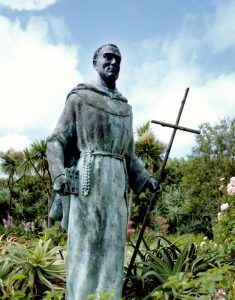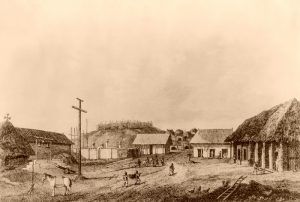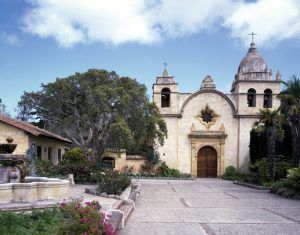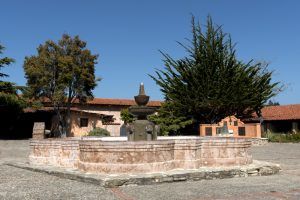The San Carlos Borromeo de Carmelo Mission, located in Carmel-by-the-Sea, California, is one of the state’s most authentically restored Roman Catholic mission churches. Today it is listed on the National Register of Historic Places and is a National Historic Landmark.
By the late 1700s and early 1800s, Spain extended its New World Empire by establishing permanent settlements on the west coast of North America. To colonize Alta (Upper) California, the Spanish constructed presidios and missions. In total, the Spanish established four presidios and 21 missions throughout Alta California. The Carmel Mission was the second of Spain’s missions built in California.
In June 1770, Captain Gaspar de Portola and Franciscan Father Junípero Serra founded the Carmel Mission and the Presidio of Monterey beside Monterey Bay. Over the course of the next year, Presidio soldiers often mistreated the local American Indians living in the area. The American Indians, who associated the mission with the Presidio, became leery of Father Serra and his attempts at converting them to Christianity.
In August of 1771, Father Serra moved the mission to nearby Carmel because it offered better agricultural land and a safer political environment for the growing mission. In this new location, the mission thrived. It was closer to freshwater and land more suitable for growing crops. Importantly, it was removed from the tense environment surrounding the Presidio. While construction progress was slow, the mission eventually had temporary structures, including dwellings, a storeroom, and a wooden church. As time passed, the wooden structures were replaced with adobe.
Carmel Mission became the headquarters for Father Serra and Spain’s expanding California mission system. From Carmel Mission, he directed the building of seven other missions in California. Father Serra passed away at the mission on August 28, 1784. Today, visitors to the restored Carmel Mission can see the room in which Father Serra slept and where he passed away. Father Serra’s grave is below the mission’s present church altar.
In 1793, Father Fermin Francisco de Lasuen, Father Serra’s successor, supervised the construction of a more permanent stone church on the site of the original adobe church. Laborers quarried sandstone from the nearby Santa Lucia Mountains. The church has two dissimilar towers flanking a round-arched portal. The bell tower, which exhibits Spanish-Moorish influence, has a dome surmounted by a wrought iron cross. At the height of its use, the church had as many as seven large-scale side altarpieces, over 20 statues, and a large crucifix flanking statues of Our Lady and St. John. The church’s interior wooden tunnel vault, shaped in a parabolic arch, is unique among the California mission churches. The church is also unique because it was the first of three California mission churches built from stone – the rest of the mission churches are of adobe. Father Lasuen was also in charge of completing nine more mission churches in California.
The mission continued to thrive under Father Lasuen’s leadership. He directed the construction of additional adobe buildings around the property. Today, the reconstructed mission buildings sit on top of the foundations of those Father Lasuen directed to be constructed. Father Lasuen passed away in 1803 and rests beside Father Serra.
By the early 1820s, a series of events negatively affected life at the mission. Sickness, death, and depredation by the military overwhelmed the mission. In 1821, Mexico gained its independence from Spain, and Alta California became a part of Mexico. The Mexican government did not have the necessary financial resources to maintain the mission system as the Spanish had done. By 1834, the Mexican government secularized the mission system and began converting church property to private property. Mexican citizens who were helpful during the war for independence and new settlers coming to California bought most of this property. Due to the secularization of the missions, the American Indian converts and Spanish Fathers left Carmel Mission, and the mission’s buildings faced deterioration and decay.
Afterward, many of the mission’s adobe buildings returned to the earth, becoming piles of mud, while the church’s roof collapsed, leaving the interior exposed to the elements. By 1859, the United States government, which was now in control of California, returned the missions’ lands to the Catholic Church. Carmel Mission lay in ruin. Restoration of the mission began in 1884 when private funds provided a new roof for the church. Two years later, in 1886, ownership of the mission was transferred from a group of Franciscans to the Diocese of Monterey. The mission has been a parish within that diocese ever since.
By 1936, private funds and church funds became available for a full-scale renovation of the property. Over the next two decades, the mission’s buildings were rebuilt and restored, and in 1961, it was designated a Basilica, the highest honorary rank for a church and implies great historical and artistic importance.
Today, visitors to the restored and reconstructed Carmel Mission will see the mission with its complete quadrangle courtyard. Only part of the mission buildings date from the 18th and 19th centuries, while others are of more recent construction but are still in the California mission style. Many of the church’s interior furnishings are original. In 1851, Monterey Pastor Father Villarasa removed the church’s statues, paintings, and other artifacts when the church’s roof showed signs of collapse. The Old Presidio Chapel in Monterey then used the furnishings until the early part of the 20th century when they were returned to Carmel Mission. Visitors to the mission will also see California’s First Library (founded in 1770) that contains Father Serra’s 400-year-old Bible. It is the only Spanish mission in California that has its original bell and bell tower.
The mission is open daily, but visitors should be aware that the mission is an active parish and has services on Sunday mornings and events such as weddings and funerals during the week, limiting accessibility. There is an admission fee to tour the church and grounds.
More Information:
Carmel Mission Basilica
3080 Rio Road
831-624-1271
Compiled by Kathy Weiser-Alexander/Legends of America, updated August 2021.
Also See:
A Day in the Life of a Spanish Missionary
List of Missions & Presidios in the United States
Missions & Presidios of the United States
Spanish Missions & Presidios Photo Gallery
Source: National Park Service





